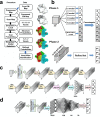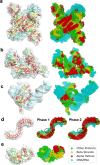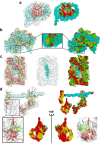Detecting protein and DNA/RNA structures in cryo-EM maps of intermediate resolution using deep learning
- PMID: 33863902
- PMCID: PMC8052361
- DOI: 10.1038/s41467-021-22577-3
Detecting protein and DNA/RNA structures in cryo-EM maps of intermediate resolution using deep learning
Abstract
An increasing number of density maps of macromolecular structures, including proteins and DNA/RNA complexes, have been determined by cryo-electron microscopy (cryo-EM). Although lately maps at a near-atomic resolution are routinely reported, there are still substantial fractions of maps determined at intermediate or low resolutions, where extracting structure information is not trivial. Here, we report a new computational method, Emap2sec+, which identifies DNA or RNA as well as the secondary structures of proteins in cryo-EM maps of 5 to 10 Å resolution. Emap2sec+ employs the deep Residual convolutional neural network. Emap2sec+ assigns structural labels with associated probabilities at each voxel in a cryo-EM map, which will help structure modeling in an EM map. Emap2sec+ showed stable and high assignment accuracy for nucleotides in low resolution maps and improved performance for protein secondary structure assignments than its earlier version when tested on simulated and experimental maps.
Conflict of interest statement
The authors declare no competing interests.
Figures





Similar articles
-
Protein Secondary Structure and DNA/RNA Detection for Cryo-EM and Cryo-ET Using Emap2sec and Emap2sec.Methods Mol Biol. 2025;2867:105-120. doi: 10.1007/978-1-0716-4196-5_6. Methods Mol Biol. 2025. PMID: 39576577
-
Protein secondary structure detection in intermediate-resolution cryo-EM maps using deep learning.Nat Methods. 2019 Sep;16(9):911-917. doi: 10.1038/s41592-019-0500-1. Epub 2019 Jul 29. Nat Methods. 2019. PMID: 31358979 Free PMC article.
-
Secondary Structure Detection and Structure Modeling for Cryo-EM.Methods Mol Biol. 2025;2870:341-355. doi: 10.1007/978-1-0716-4213-9_17. Methods Mol Biol. 2025. PMID: 39543043
-
Advancing structure modeling from cryo-EM maps with deep learning.Biochem Soc Trans. 2025 Feb 7;53(1):259-65. doi: 10.1042/BST20240784. Biochem Soc Trans. 2025. PMID: 39927816 Free PMC article. Review.
-
Smart de novo Macromolecular Structure Modeling from Cryo-EM Maps.J Mol Biol. 2023 May 1;435(9):167967. doi: 10.1016/j.jmb.2023.167967. Epub 2023 Jan 18. J Mol Biol. 2023. PMID: 36681181 Review.
Cited by
-
Assessment of Protein-Protein Docking Models Using Deep Learning.Methods Mol Biol. 2024;2780:149-162. doi: 10.1007/978-1-0716-3985-6_10. Methods Mol Biol. 2024. PMID: 38987469 Review.
-
Novel Artificial Intelligence-Based Approaches for Ab Initio Structure Determination and Atomic Model Building for Cryo-Electron Microscopy.Micromachines (Basel). 2023 Aug 27;14(9):1674. doi: 10.3390/mi14091674. Micromachines (Basel). 2023. PMID: 37763837 Free PMC article. Review.
-
Unveiling the stochastic nature of human heteropolymer ferritin self-assembly mechanism.Protein Sci. 2024 Aug;33(8):e5104. doi: 10.1002/pro.5104. Protein Sci. 2024. PMID: 38995055 Free PMC article.
-
Protein Structural Modeling for Electron Microscopy Maps Using VESPER and MAINMAST.Curr Protoc. 2022 Jul;2(7):e494. doi: 10.1002/cpz1.494. Curr Protoc. 2022. PMID: 35849043 Free PMC article.
-
CryoREAD: de novo structure modeling for nucleic acids in cryo-EM maps using deep learning.Nat Methods. 2023 Nov;20(11):1739-1747. doi: 10.1038/s41592-023-02032-5. Epub 2023 Oct 2. Nat Methods. 2023. PMID: 37783885 Free PMC article.
References
Publication types
MeSH terms
Substances
Grants and funding
LinkOut - more resources
Full Text Sources
Other Literature Sources

